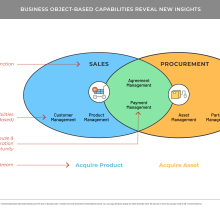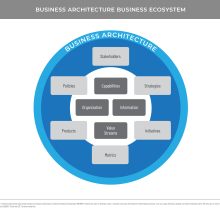There are topics that can make us scratch our business architecture heads and this installment of StraightTalk explores a few of them. As we think through them, we need to embrace nuance, context, bridge building, and purpose.
The first goal of this StraightTalk is to remind you that you’re not crazy and you’re not alone. The second and most important goal is to not to create agreement but rather to create clarity and understanding around these topics – because that creates a place for us to come together and move forward.
For a discipline that is all about building common understanding among people, we have some misalignment of our own. Here are a few topics related to the basics, which turn out not to be so basic after all….
“Interoperability is really important in today’s world…[People come together to agree on a standard] because cooperating about a standard makes their own product work better.”1
– Seth Godin
What is a capability?
Common Questions
I thought I understood, but what’s a capability again? And how to do I model it?
A Straight Talk Perspective
There are two key areas where interpretation differs. Oftentimes people do not realize it and talk past each other, assuming they are coming from a place of common understanding, but the disconnect magnifies as we talk about using capabilities for things like analysis, strategy translation and solution design.
- Capabilities defined as unique actions performed on business objects versus capabilities defined as functions (hybrid approaches exist as well) — The BIZBOK® Guide defines capabilities based on business objects and does so to create a non-redundant framework that reveals new insights across silos and informs effective solution design. See more about this in Posts No. 51, No. 52 and No. 12. Other methods primarily define capabilities along functional lines which is more familiar and comfortable to people but does not always bridge silos or challenge peoples’ thinking. Business services are often defined functionally and as a result intentionally do not exist in the BIZBOK® Guide for the same reason. Here’s a handy diagram to illustrate the difference.
- Capabilities defined as cross-mapping to people, process and technology versus encapsulating them – The BIZBOK® Guide follows the principle of separation of concerns and so it relates capabilities to other architectural domains and operating model domains (people, process and technology). This provides a more flexible framework for analysis from any angle. Other methods define a capability as more or less a bundling together of people, process and technology with the same thinking as #1 commonly applied.
Common Ground
Capabilities are a necessary construct to help organizations organize and optimize the resources needed to deliver stakeholder value and execute change initiatives. They are best suited for this purpose when they represent a non-redundant view of an organization.
What is a value stream?
Common Questions
What is a business architecture value stream? How is it different from other types of value streams and value chains? Isn’t it a high-level process?
A Straight Talk Perspective
- While we are focused on business architecture value streams here, other types exist such as Lean value streams and SAFe value streams. All three are different in form, function and intent.
- There are different definitions and interpretations of value chain. In a strategic context, it may refer to the Porter value chain. In a process context, it may be used as a higher-level organizing construct. In a management consulting context, it may show a high-level flow of a “business on-a-page” to which functions or capabilities can be mapped.
- In business architecture, value streams ≠ value chains. Value streams are architecturally robust concepts that are reflected in the business architecture metamodel. Value chains are used sometimes, primarily as a view for strategic discussions.
- Business architecture value streams as defined in the BIZBOK® Guide are flexible, event and state-based frameworks, with a defined set of principles for creating them. They are not intended to be high-level processes and there is a significant amount of rigor and intention that goes into scoping and defining a value stream to ensure that it truly represents value for an internal or external stakeholder within the context of an organization and its entire ecosystem. See more in Post No. 12.
- Capabilities are cross-mapped to value stream stages and may be reused many times across them.
Common Ground
Capabilities alone are not enough and need a flow- and value-based construct to provide context for their usage. Flow-based views (whether value streams, value chains or processes) should be based on a defined, repeatable set of principles. Flow-based views tend to resonate well with people where capabilities may not feel as familiar. Both are necessary and become particularly powerful when related to and used in conjunction with each other.
What is business architecture?
Common Questions
What is business architecture again? And what is it not?
A Straight Talk Perspective
- Consider that what business architecture is — set of business views2 — may perhaps be less interesting than why it is. Business architecture provides the big picture across silos — using a common language that offers a broader scope of focus with a longer-term perspective — to facilitate effective strategy execution, decision-making and design of organizations and ecosystem. Business architecture shifts mindsets and it can be used by anyone within an organization, though there is a specific business architect role that focuses on the creation and usage of business architecture.
- There are also different definitions and interpretations of what business architecture comprises. The BIZBOK® Guide defines the scope of business architecture as the ten domains shown below, with capabilities and value streams forming the centerpiece of an organization’s business architecture to which other domains may be cross-mapped. Individuals, organizations and other methods do define business architecture differently, often to include domains such as capabilities, processes (which the BIZBOK® Guide connects to as part of the operating model) and business functions. Again, the BIZBOK® Guide approach is guided by the concept of separation of concerns, which provides maximum flexibility in how information may be leveraged for many different business usage scenarios. The expanded set of domains not only means that more intelligence can be captured, but it also means that the capability map does not have to be all-encompassing and represent aspects such as products and organization. See more in Posts No. 1 and No. 63.
- Business architecture is a business discipline and is a domain within the broader enterprise architecture umbrella.
Common Ground
Business architecture is often missing but entirely essential for organizations. Business architecture provides the scaffolding that connects everything, providing traceability from strategy through execution and offering aggregate views across an entire organization. It helps us design better organizations and ecosystems. It provides the business lens and priority for enterprise architecture.
Our greatest challenge and opportunity with business architecture lies in how well we deliver relevant value within a broader business context. Here are a couple of topics related to business architecture in the bigger picture (briefly described)...
How do business architecture and business design relate?
Common Questions
What is the difference between business architecture and business design? Are they the same? Is one part of the other?
A Straight Talk Perspective
- There are different definitions and interpretations of business design. Some people refer to it as the collection of disciplines that work together from an outside-in human perspective and an inside-out organizational perspective to inform and translate changes to an organization into actionable initiatives. Some limit its scope to focus more on experience design and business architecture. Some people have just renamed business architecture to business design because the term is better received.
- Let’s focus the discussion on experience design (for customers, partners and employees) and business architecture. Consider these to be separate disciplines that work together well for mutual benefit. More here in Post No. 16.
- Some people blend experience design and business architecture (and even other disciplines) together as part of their role. While this works very well for some, not everyone is adept at flowing across left brain and right brain activities.
- Keep in mind that other people do not necessarily see or care about the boundaries of different disciplines, so we need to work together seamlessly to solve problems and serve our organizations.
- Design Thinking is a methodology for problem-solving which applies human-centered techniques to solve problems in a creative and innovative way. It also co-exists and interacts with business architecture for mutual benefit. Design Thinking could be leveraged at different points during strategy execution, such as to inform target state architectures and solution designs.
- Now that business architecture is formalizing and gaining traction, it is detrimental to simply rename it to business design. A better approach to address socialization challenges within an organization is to position the discipline within a broader context of value and alongside other disciplines.
Common Ground
We’re stronger together and need to consider both outside-in and inside-out perspectives. Human-centered approaches that focus on customer empathy and experience design tend to resonate well with others, which can provide context and relevance for business architecture – while business architecture can help to inform and translate customer needs into action. Individuals and organizations should understand the disciplines and how they fit together but have the freedom to blend them in practice.
How do business architecture and agile approaches relate?
Common Questions
How does business architecture fit with and add value to agile approaches such as SAFe? Is it still relevant? Won’t it slow things down?
A Straight Talk Perspective
- Organizations need both execution agility and end-to-end organizational agility. Agile development practices alone do not enable an organization to achieve end-to-end agility, but business architecture does.
- In the article “Architect Your Company For Agility,” author Jeanne Ross states that “The challenge is ensuring that the efforts of individual teams align to achieve company-wide objectives. Our research at the MIT Center for Information Systems Research has identified three mechanisms for achieving alignment: (1) clear missions, (2) common business components, and (3) fruitful knowledge sharing.”3
Business architecture and business architects help with all three. They benefit and empower agile teams by:
- Articulating clear, coordinated business direction
- Framing work within a business context
- Providing a common vocabulary and mental model
- Informing prioritization
- Defining reusable business components
- Connecting the dots across the teams and the organization
- Business architecture is not an impediment to an organization’s agility but is rather the gateway to successfully achieving agility. See more in Post No. 27.
Common Ground
Both execution agility and end-to-end organizational agility are important; agile and business architecture teams play different but important and complementary roles. While business architecture focuses on the business and translating business direction, agile teams are the mechanism that deliver the results.
Sure, we have some controversy and debate, but we also have promise. While we might sometimes see and describe the what a little differently, the more important perspective to keep in mind is how aligned we are on the why. Around the world, business architects share similar characteristics, mindsets, and aspirations. They are rare people who are passionate, uniquely talented and truly care about creating better organizations and societies. That is something to rally around.
More Good Stuff...
The Psychology of Human Misjudgment (Charlie Munger): A talk by Charlie Munger and its transcript on 24 causes of human misjudgment. Powerful, a bit mind-blowing, and maybe one of the most important things we can read right now.
What Is Business Architecture? (Kuehn White Paper): Just in case you haven’t read it yet, check out this foundational white paper that cuts through the myriad of content available on the topic of business architecture to help you understand what it really is and is not.
Sections 2.2 and 2.4 of the BIZBOK® Guide (Business Architecture Guild®): The full story on capabilities and value streams from the source: the BIZBOK® Guide. (Business Architecture Guild® membership required.)
20 Minute Capability Mapping and 20 Minute Value Stream Mapping (BA Guild webinars): Two of the most popular webinars on capability and value stream mapping. They are Guild classics. (Business Architecture Guild® membership required.)
Business Architecture Reference Models (BIZBOK® Guide): You can view business architecture reference model content including capability maps, value streams, information maps and other maps in Part 8 of the BIZBOK® Guide (Business Architecture Guild® membership required). Downloadable content is also available in the by the Business Architecture Guild®store for both members and non-members (at a cost).
Business Architecture and the Customer Experience: A Comprehensive Approach for Turning Customer Needs into Action (Business Architecture Guild® White Paper): A white paper that establishes how the customer experience design and business architecture disciplines work together.
Business Architecture: The Gateway to Transformation an Organization Into an Agile Enterprise (Kuehn and Ulrich White Paper): This white paper illustrates how business architecture can be a gateway for an organization to transform itself into an agile enterprise, supported by a government case study.
Dare to Disagree (TED Talk): A TED Talk by Margaret Heffernan on the importance of thinking partners who aren't echo chambers. “When we create conflict, we enable ourselves and the people around us to do our very best thinking.”
- 1From “Adversarial Interoperability” Akimbo podcast from Seth Godin (26 August 2020).
- 2According to the Federation of Enterprise Architecture Professional Organizations (FEAPO), “Business Architecture represents holistic, multidimensional business views of: capabilities, end-to-end value delivery, information, and organizational structure; and the relationships among these business views and strategies, products, policies, initiatives, and stakeholders.”
- 3See “Architect Your Company For Agility” by Jeanne Ross for MIT Sloan


